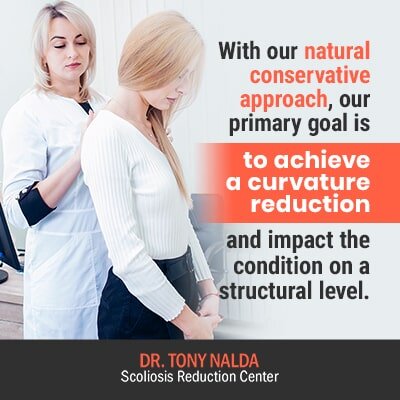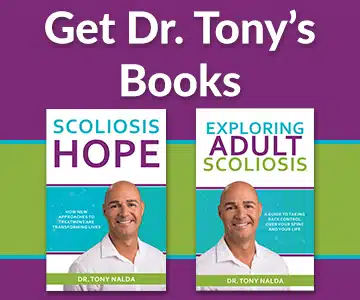Scoliosis is a progressive and incurable condition. As permanently reversing it would be akin to curing it, this is not possible; however, it is more than possible to manage and treat the condition through a natural treatment path. Known as the ‘conservative approach’, this involves an integrative approach without medication and invasive surgery.
When people ask if it’s possible to treat scoliosis naturally, they tend to mean two things; can it be treated with a DIY approach from home, and can it be treated without invasive use of medication and surgical procedures. To answer the question, we’ll first address the dangers of attempting full treatment from home. Then we’ll explore the traditional approach and move on to the benefits of seeking out natural conservative treatment administered by a scoliosis specialist.
The Risks of Self-Treatment
I’m pleased when people are being proactive with their health and seeking out alternative treatment paths. This means they aren’t automatically turning to medications and invasive surgical procedures. The flip side of that is that with some complex conditions, like scoliosis, even a more natural approach needs to be designed and administered by a trained and experienced scoliosis specialist.
Some of the most difficult cases I’ve treated are those that first attempted at-home treatment on their own. They did some research, maybe even consulted with a doctor or physical therapist, and designed a regime of scoliosis-friendly diet, exercise, and stretching. This stretching could be done with yoga sometimes too.
They had some great ideas and motivation and worked hard from home. Unfortunately, with complex progressive conditions like scoliosis, they require an integrative approach and need more than an at-home approach can deliver.
These patients come in to see me after they have realized their efforts aren’t working. At this point, their scoliosis has progressed, as it’s in its nature to do, and their efforts did little to slow or stop that progressive line.
These patients are discouraged that their efforts were fruitless. There is a strong correlation between prognosis success and early diagnosis and treatment. From my perspective, I see this as wasted valuable treatment time. That being said, it’s never too late to start treatment, and while we may be starting a little later than I would like, there is still great potential for a curvature reduction when a proactive integrative approach is applied.
Regardless of how well they embraced their scoliosis-specific exercises and lifestyle, scoliosis needs to be monitored closely through assessment and X-ray; unless people have access to X-rays at home, they can’t possibly know how their approach is impacting their spine.
The above scenario is cautionary; I want to be clear that even when patients work with us here at the Scoliosis Reduction Center®, there will be a strong at-home component, but the scoliosis exercises and stretches done at home are only one piece of the treatment puzzle we customize for our patients.
Let’s now delve into the difference between a traditional and conservative treatment approach, in addition to the multiple natural disciplines we draw from and how our patients benefit from them.
Opposing Treatment Approaches: Traditional vs. Conservative
Scoliosis has been around for hundreds of years, and the traditional approach to treatment has been firmly entrenched alongside the condition.

Still used today, the traditional approach most often involves watching and waiting to observe how a patient’s condition progresses. This doesn’t sound like a bad thing, but it is a passive approach, where an active one is best.
In progressive conditions like scoliosis, its very nature is to get worse, and it takes an active and effective response to stay ahead of that tendency. In the traditional route, a doctor would see a patient, with a mild or moderate form of the condition, and likely recommend they return every so often for X-rays to monitor its progression.
Once the curvature reaches what’s considered surgical level, often 40+ degrees, a common recommendation is to undergo spinal-fusion surgery.
In spinal fusion, the discs of the spine are removed and the vertebrae in the curve are fused together. Rods are attached to hold everything in place while the spine heals in a straighter alignment. This sounds positive, and in terms of simply straightening a crooked spine, it is; however, that comes at the cost of flexibility, and there are numerous additional risks and side effects to consider, such as the need for subsequent surgery if the first is ineffective.
Not only is spinal fusion costly and invasive, there is a real lack of long-term data on just how the surgery affects patients 30, 40, and 50 years down the road. There is also a lot of guesswork involving just how long the hardware attached to the spine will last before degenerating or breaking.
These factors, combined with the fact that it can’t always stop a condition from progressing, make it a dangerous choice in terms of risk versus reward.
Now, let’s take a look at what the conservative approach involves and offers patients.
A More Natural Conservative Approach
When I first started studying scoliosis and the popular traditional treatment approach, I saw a big gap in effective treatment options for patients. I felt there had to be a better way than simply passively watching patients’ conditions get worse until the only option was a procedure as costly, invasive, and risky as spinal-fusion surgery.
I knew there had to be alternative forms of treatment, and that’s where the proactive conservative approach we offer here at the Center comes in. Here, we believe that patients should have access to multiple forms of effective treatment available at one location.
All our treatment forms are scoliosis-specific, and we work closely with our patients to design a fully-customized approach that addresses the individual characteristics of the patient and their condition.

We combine multiple disciplines such as chiropractic, therapy, rehabilitation, and corrective bracing. We draw what we need to from each discipline and apportion them accordingly. With regular assessment and X-ray, we tweak our plan as necessary.
With our natural conservative approach, our primary goal is to achieve a curvature reduction and impact the condition on a structural level. We then work closely with our patients to give them the skills, knowledge, and resources to augment those structural results with exercises and stretches they can do at home.
We continue to monitor our patients’ scoliosis and work with them so they can live their best lives and stay ahead of the condition’s progression. As our approach is natural and noninvasive, it comes with few, if any, side effects, unlike the potential complications of spinal fusion.
For those who choose medication and injections to handle any scoliosis-related pain as a treatment method, they should be aware that this also comes with risks as pain tells us what is happening in the body. If a condition’s progression is being masked by pain meds, this too is wasting valuable treatment time.
While there are no guaranteed natural methods to reverse scoliosis, certain exercises and lifestyle adjustments may help improve spinal alignment and reduce discomfort. However, the effectiveness of these natural approaches varies from person to person. In some cases, scoliosis braces for adults may also be recommended to manage and stabilize the condition.
Exploring natural methods to reverse scoliosis involves adhering to scoliosis do’s and don’ts, and considering approaches like the Schroth method for scoliosis to promote spinal alignment and overall curvature improvement.
In addition, medicating to treat the pain does nothing to address the underlying cause of the discomfort and is only treating a symptom of the condition, not the condition itself; that’s an important distinction to understand.
Conclusion
While there is no ‘reversing’ scoliosis, it can certainly be managed and treated effectively.
By cultivating the right habits and mindset, you can explore natural ways to potentially reverse scoliosis or mitigate its side effects, such as incorporating physical therapy exercises and regularly checking for scoliosis yourself to stay proactive in managing the condition and avoid potential complications.
As a progressive condition, choosing the best possible treatment path is the most important condition-related decision you will make. While some opt for the traditional path, I’m proud to offer patients a brighter outcome through an alternative path.
Here at the Scoliosis Reduction Center®, our patients have access to multiple forms of treatment that work together to yield the best possible prognosis. Through a natural and noninvasive integrative approach, we address the structural nature of the condition and work to manipulate the spine to move itself into a straighter alignment. We work to correct, stabilize, and support the spine. Once this is achieved, we continue working with our patients to ensure the results are sustainable.
Through our approach, we offer our patients the chance to benefit from natural scoliosis treatment that offers positive results without risk of complications or heavy side effects.
If you have recently been diagnosed with scoliosis, make sure you explore all treatment avenues available to you before committing to one; that decision can impact how you experience life with the condition.





